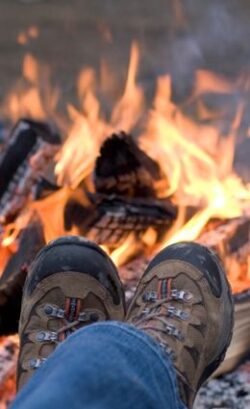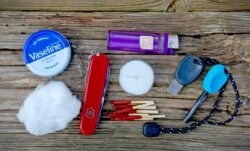When ancient humans discovered fire, they became able to improve their quality of life, health, and survival. Staying warm, cooking food, and turning night into day means survival.
When I watch these survival shows like Alone, Survivor, Dual Survivor, and other man against the element’s adventures, two things come to my attention. I am amazed how few of them know how to make or start or fire. They struggle for days trying to make a spark. Once they finally get a fire, they run out of wood to feed it or burn down their shelter.
They were obviously not Boy or Girl Scouts. When I was a young Scout, we had seasonal competitions at Camporees. One station was a timed Flint and Steel fire starting. My best time was under 30 seconds! Heck, that is almost as fast as a match. The Flint I used was a chunk of flint that I found, along a trout stream called Basin Run. My steel was a piece of broken file, that I broke and got into trouble with my dad over. A couple foot length of twine was separated and made into a nest. The trick was to add some charred cotton cloth to the nest center. You could also use steel wool, but the Scout’s rules did not allow it.
I kept my fire fixings in an old metal Sucrets Lozenges can. It was no bigger than a wallet and light. I wrapped the inside goodies in foil for additional protection. This Fire Starter kit always traveled with me outdoors. It was in my fishing vest, hunting coat, backpack, or canoe bag. Being Prepared is what Scouting is all about. The truth is that if you are Prepared, you are conscious of the threat and will probably avoid it.
My Fire kit was more Old School. Today, you can easily make your own emergency fire kit using more modern fire starter tools. A magnesium rod, struck with a knife blade makes great sparks. I have had these sparks ignite dry leaves, that I pulled out of tree roots, on a rainy day. Pocket lighters will also work. Waterproof matches last well and can save your life. Small flares can help out in a hurry.
Mountain Men often wore their Fire Fixins in a pouch around their necks. A bit of gunpowder would help in a pinch. Other accelerants like pine sap, tar, or rendered fat would also work. Today I also carry a small candle and chap stick. Birch bark, wood shavings, and dried sage are also a good trick.
Whatever you prefer, practice with it. Time is essential when freezing. Have friendly camp competitions. You will be amazed at how much you can learn. Fire kindling and preparation are vital to getting the fire going. You need extra dry grass, twigs, mouse nests, and flammable fibers to take a spark or ignite.
Several years ago, I was drifting the lower Yellowstone River. This area has little boat traffic and is remote. As we came around a bend, I noticed a flipped canoe and 3 cold, hypothermic, shivering kids on the bank. Their gear and paddles were downriver. The snow was going down and they were stranded.
We quickly beached our boat and had a fire going in less than 5 minutes. There was plenty of dry driftwood and we heated rocks. Our raingear, extra clothes from our boat box helped them get dry. Each kid placed a heated rock under their armpits and in their hands. Within a half an hour, they were dry, comfortable, and ready to float the last few miles to their takeout. We recovered their paddles and gear. Within an hour, they were in their parents’ truck and safe. This story could have ended tragically!
Flame on!
Montana Grant